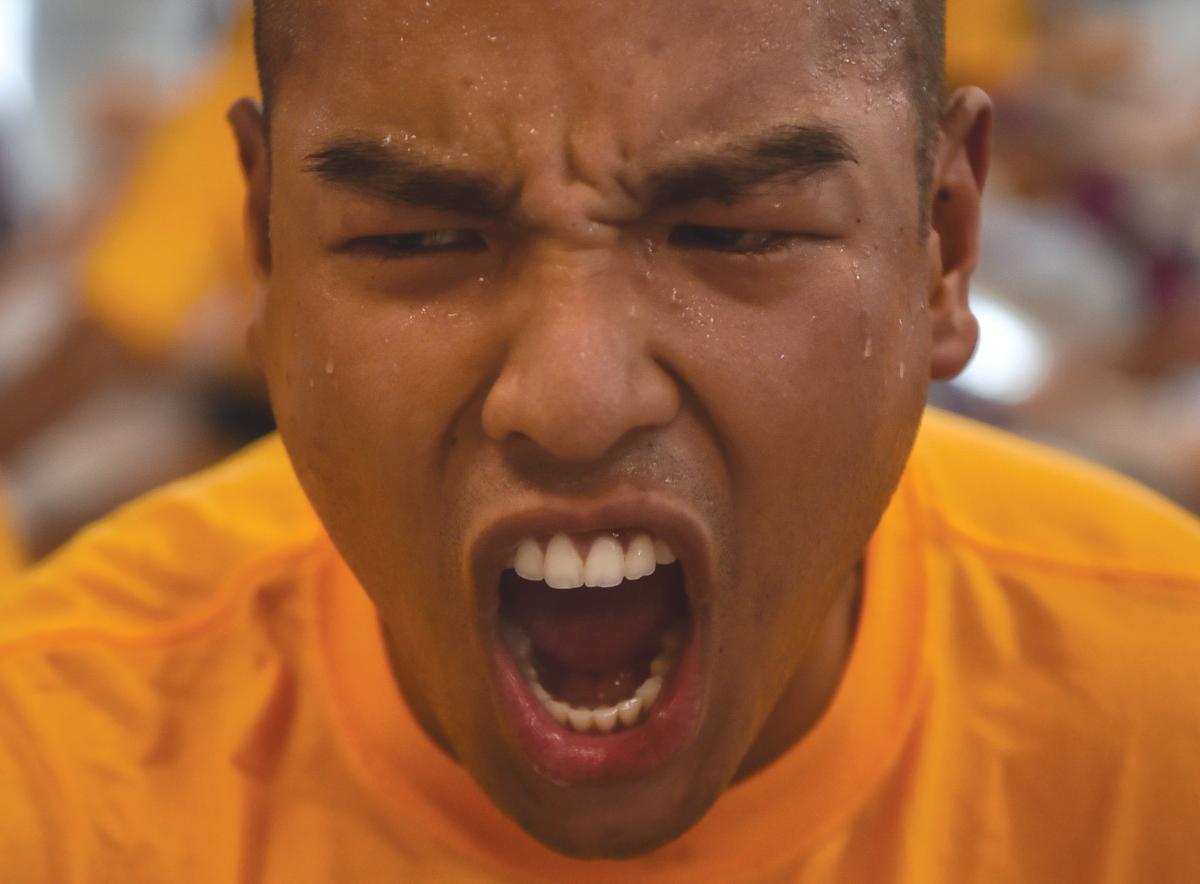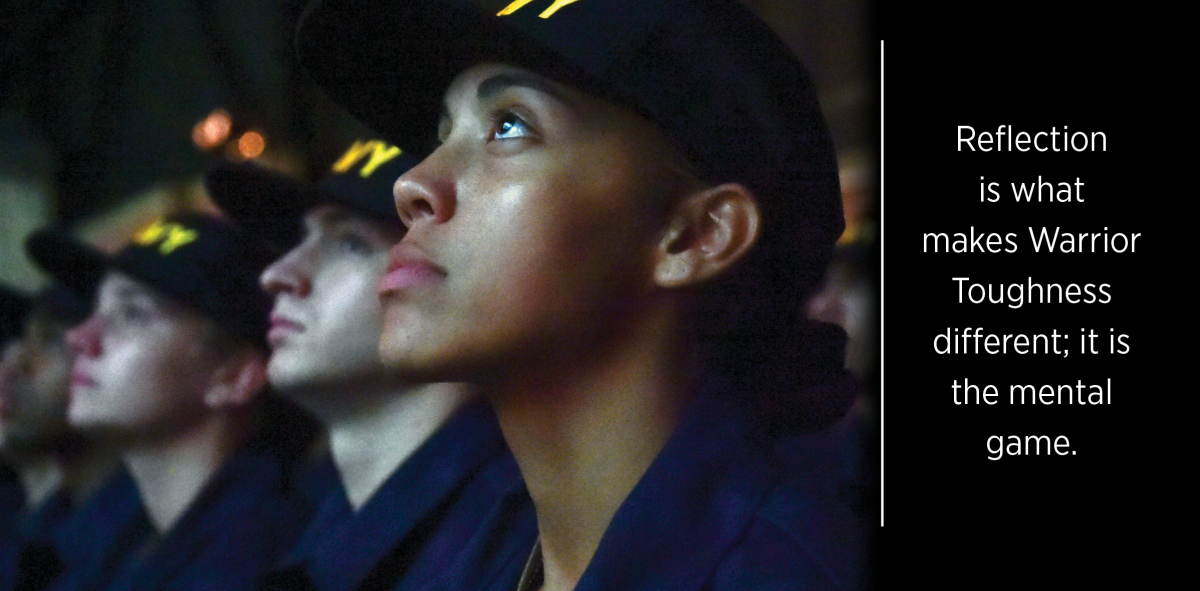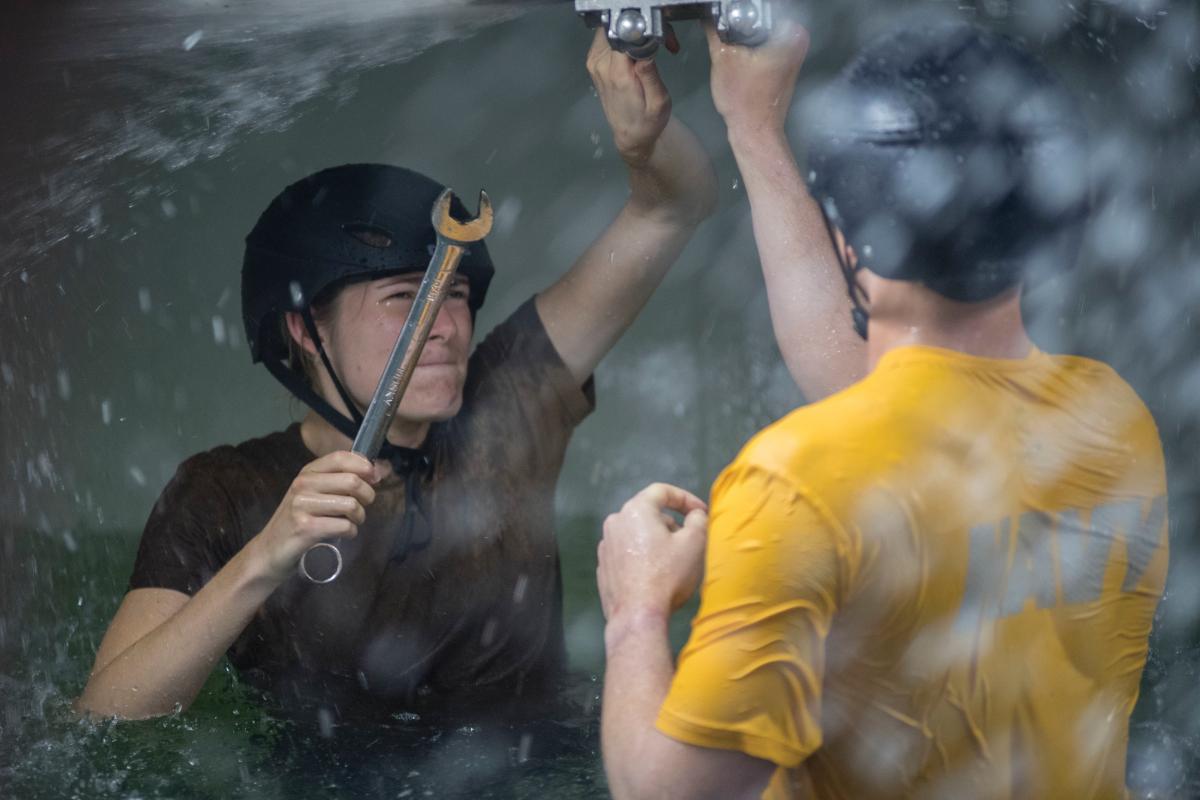It is the middle of the night. Only the midwatch is awake, diligently recording logs and keeping the ship safe. Suddenly, alarms blare and the ship violently shakes the crew awake. Fears grow worse when “man overboard” is announced over the 1MC. Divisions race against the clock and the frigid winter waters to take muster. This is a scenario that makes any sailor shudder, and one that keeps many a captain up at night.
This heart-pounding and sweat-inducing scenario happens at boot camp every day. The watchstanders are recruits. The scrambling divisions, also recruits. The emergency responders, recruits. The voice over the 1MC, a recruit. Recruits now spend their days drilling just like ships at sea; standing watch, earning qualifications, and training under the same stressful conditions endured by sailors in the fleet. Adding to the realism, boot camp instructors are forbidden to intervene except in matters of recruit safety. They are allowed only to monitor and, of course, grade and critique.
This is a small glimpse of a new boot camp curriculum rooted in “Warrior Toughness.” Close to 70 percent of the training was transformed with one goal in mind: Navy readiness.
What is Warrior Toughness?
Toughness as a concept is nothing new. The Navy’s history is full of sailors who have performed their duties exceptionally under fire and under great stress. Whether you call it resiliency, grit, or fortitude, toughness is fundamental to the Navy’s combat edge and has been a part of its identity since John Paul Jones engaged HMS Serapis in her home waters.
Toughness is defined in A Design for Maintaining Maritime Superiority, Version 2.0:
We can take a hit and keep going, tapping all sources of strength and resilience. Through rigorous training for operations and combat, the fighting spirit of our people, and the steadfast support of our families, we maintain a culture of warfighting excellence and hone our warfighting ethos. We don’t give up the ship, we never give up on our shipmates, and we never give up on ourselves. We are never out of the fight.” 1
This definition has spurred a Navy-wide conversation about toughness. Everyone, in every command, is looking for tougher sailors, but the question always has been, How do we create them?
The answer sounds like the beginning of a joke: A chaplain, a psychologist, and a SEAL walk into a bar . . . only instead of a bar, it was the Navy’s boot camp.
At Recruit Training Command (RTC), toughness is found—and trained—at the intersection of spiritual, mental, and physical strength, and bringing together a chaplain, a psychologist, and a SEAL to instruct reinforces the importance of that “whole person” concept. They speak the same language of toughness, but in different dialects, from their own perspectives, expertise, and experience. The psychologist offers psychological exercises, the chaplain provides character development grounded in larger systems of meaning and purpose, and the warrior brings an operational perspective and the mind-set necessary to accomplish the mission. In other words, the psychologist provides the how, the chaplain provides the why, and the SEAL provides the so what?
RTC has been working for the past 18 months to make Warrior Toughness training a reality, and after several successful and a few unsuccessful pilots, it went RTC-wide in October 2018.
Our newest sailors must be rigorously trained and smartly disciplined; they have to know their systems of support; they have to have a fighting spirit. Underlying all these sources of strength and resilience is a spiritual, character-based approach that incorporates proven mental and physical techniques. In short, there is no magic pill; the key to putting the mind, the body, and the soul in harmony is simply a lot of hard work.
Warrior Mind-set
They are trying to mold you into someone who can be counted on to do the correct thing at the right moment, that might make the difference in whether one of your shipmates lives or dies, or a mission is completed successfully, or a battle is won. . . . It is that profound.
Retired U.S. Coast Guard captain to his nephew, who entered the Navy in 2018
The warrior mind-set is the linchpin of the mind, body, and soul framework. It comprises four elements: commitment, preparation, execution, and reflection.
Commitment is the investment given to a task, the organization, and fellow shipmates. An individual’s commitment is directly linked to a sense of purpose. When a sailor has a strong sense of purpose, he or she is more committed to the mission and more disciplined in preparing for those high-stakes moments when everything is on the line.
Preparation is an investment in traditional training, skills, and knowledge. In areas such as physical fitness, the Navy needs higher standards. In tactical training, it needs more realistic scenario-based training for sailors. In character development, it needs an understanding of what integrity, accountability, toughness, and initiative look like.
Execution is where it all comes together. When the bullets are flying, when the stakes are high, we need to perform at our best. In SEAL teams, this often is referred to as being “On the X.” In these moments when it matters most, both professionally and personally, we must be able to maintain focus and situational awareness and execute contingencies.
Reflection is what makes Warrior Toughness different; it is the mental game. Reflection is an individual or collaborative process that extracts value from experiences and uses it to inform future steps. A strong character and techniques from performance psychology and mindfulness give sailors an edge when they are called to perform in high-stakes moments.
Applied Psychological Exercises
A wealth of evidence demonstrates the benefits of mindfulness and sports psychology for emotion regulation and performance.
At RTC, mindfulness is defined as “in-the-moment self-awareness.” Exercises such as focused breathing, progressive muscle relaxation, body scan, and cognitive diffusion are practiced every day over the eight weeks of boot camp. After physical training, recruits practice lowering their heart rates, regulating their breathing, and improving their focus while in an elevated state of physiological activity. During evening routine, they use the skills to reset after a long day of training (and prepare for a possible midnight drill).
Performance psychology incorporates skills known as “The Big Four”:
- Goal setting, focusing on performance objectives, has long been a part of RTC’s curriculum.
- Self-talk, which creates awareness of beliefs and their consequences, is taught at the baseline physical fitness assessment (PFA).
- Visualization, or mental rehearsal, is introduced at the initial swim qualification.
- Energy management uses physiological stimuli to influence the mind and is incorporated into the basic seamanship lab.
RTC’s chaplains, ship’s officers, recruit division commanders, and instructors teach and reinforce these concepts throughout boot camp. It is vital that these skills are introduced in the context of high-stress evolutions to allow for immediate application. Learning about performance psychology or mindfulness solely in a classroom is not effective in integrating these skills.
During pilot experiments, applied-exercises training resulted in statistically significant improvements in performance on the PFA, initial swim qualification, dynamic material inspections, personnel inspections, and graduation rates. Of course, it does the Navy no good if these techniques work only in boot camp, so research participants will continue to be tracked through their first enlistments.
Character Development
Character plays a compelling role in the transformation from civilian to sailor. Values, morals, and ethics are part of sailors’ vernacular, and they play an important role in fostering toughness.
The Warrior Toughness character development syllabus is rooted in the Navy’s core values (honor, courage, and commitment) and core attributes (integrity, accountability, initiative, and toughness). Recruits and staff explore each attribute through instruction, reflection, dialogue, and real-world case studies. Central to the character conversation are the values, beliefs, and principles that guide us individually and collectively in making decisions and setting priorities.
Throughout their journey to becoming tough warriors, recruits reflect on their sources of strength and resilience: rigorous training, fighting spirit, and steadfast support. They further reflect on how these sources support their adherence to values, beliefs, and guiding principles. As sailors embody these attributes and act in accordance with personal and professional core beliefs, they respond with resolve to mental, physical, and spiritual hits; they are able to weather prolonged stress and maintain their ability to think and act appropriately under fire. Toughness is essential to everything sailors do and the culmination of everything they choose.
The Need for Warrior Toughness
Toughness is fundamental. Being part of this warfighting service requires that we put ourselves in harm’s way. We need to maintain clarity of thought and action in the heat of battle, when our shipmates count on us most.
Former RTC commanding officer Captain Mike Garrick
The Navy lost 17 sailors recently, and it was devastating. We cannot bear to imagine even one more sailor lost, but it is our duty to prepare for scenarios that threaten thousands more.
Could we take a hit, quickly gather our strength, and then deliver the killing blow to the enemy and put their fleet on the bottom of the ocean? Are we training to that standard or with that in mind? We have not seen that kind of major fleet combat since World War II, yet when you look at the competition, they are preparing—so must we. That is our new mission and the drive for change, to prepare our sailors for combat on day one, and the ability to deal with stress at sea.
Although RTC began its efforts to improve how we instill toughness in recruits before the ship collisions of 2017, those devastating losses caused us to pause and reflect, and reinforced the need for us to implement tangible, effective toughness-building approaches into our training. We made toughness one of the core competencies of a U.S. Navy sailor, just like basic damage control, firefighting, and line handling.
In the Navy, we never know when we will experience life-threatening situations. It may be responding to a natural disaster as part of a humanitarian assistance/disaster relief task force, combating terrorists or piracy, force on force at sea or ashore, or fighting to save the ship after a fire or flooding. We expect our service members to stand and face the threat. We expect them to save their ship. After all, we “Don’t Give Up the Ship.” But many forget the second phrase of this iconic saying, and with the return of great power competition, it might be time to bring it back to the forefront: “Fight her till she sinks.” The point is that toughness always has been part of our DNA, and it is our duty to develop the most efficient and effective way of building up our foundations of toughness.
We also have seen that beyond the battlefield and operational deployments, our sailors often face the potentially debilitating effects of stress, while struggling to find a realistic work–life balance or reintegrate into their families’ lives after months away from home. Sailors need to face personal stressors with the same capacity for toughness that they apply to their professional lives—a stable home life allows us to focus on our mission.
We owe our sailors tools that can be used at sea and on the battlefield as well as in aspects of their everyday lives.
Reflections to Date
The real question is: What does the fleet think? It is still too early to tell, because the test is how well the upcoming Warrior Toughness generations fight, but preliminary results are encouraging.
Overall physical fitness, inspection results, and performance scores have improved, in some cases significantly. The teaching techniques and improvements in warfighting basics have allowed Damage Control A School and Boatswain’s Mate A School to advance their curriculum because the sailors graduating from boot camp now have higher levels of skill.
Recruits must now pass four different phases and demonstrate individual and team skills where everything is graded, including Battle Stations, which is now 30 percent of their final grade. Recruits stand watch 24/7, are awakened in the middle of the night, and practice high-stress hands-on drills, and despite the increased rigors, attrition has been nearly cut in half.
The way forward for the Warrior Toughness program at RTC focuses on expanding the training audience and refining/improving the quality of the training based on outcomes. Over the next few years, Warrior Toughness will be rolled out to the entire RTC staff of more than 1,000, as well as all recruits (approximately 40,000 annually). In addition, embedded mental health professionals started providing preventative mental health services to all RTC staff. To truly reap the benefits of this training, however, Warrior Toughness needs to expand beyond the lifelines of RTC.
Naval Service Training Command began mirroring Warrior Toughness in officer training at Reserve Officers Training Corps and Officer Training Command. RTC has taken the first step outside its lifelines by teaming with Nuclear Power Training Command for follow-on Warrior Toughness training, so it can evolve into a learning continuum that progresses from RTC to A Schools, C Schools, and then to the fleet. Naval Reactors has been helping us in character development, watchstanding, and other areas while we have been teaching their instructors the Warrior Toughness curriculum.
To Win the Next Fight
Being tough always has been fundamental to being a U.S. Navy sailor. RTC’s Warrior Toughness program seeks to imbue sailors with the warrior mind-set, supported by physical fitness, strong character, and proven mental fitness techniques—all necessary to win the next fight.
So out in the fleet, if you notice young sailors pausing and beginning to breath in a controlled manner for a brief moment during your next general quarters drill, don’t worry! They are focusing everything they have, and they are going to give it their all to fight for their shipmates and their ship.
1. ADM J. M. Richardson, USN, A Design for Maintaining Maritime Superiority, Version 2.0, December 2018, 7.









